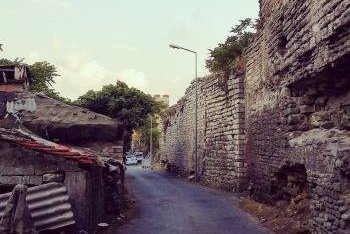
I feel myself lucky as I've been able to call Istanbul my home for one year. It has given me the possibility to explore the city slowly and especially it's vast historic areas on Fatih peninsula.
The World Heritage site is made up of 4 different quarters. The most famous of them is the Sultanahmet area at the tip of the peninsula. From here you can find the biggest attractions: Hagia Sophia (Ayasofya), Blue Mosque (Sultanahmet Camii), Topkapi Palace (Topkapi Sarayi) and Basilica Cistern (Yerebatan Sarayi). This is the area you want to avoid visiting while you live in the city as it is overrun by tourists for most of the year and prices are higher than elsewhere in the city. After visiting the attractions (which are magnificent, there’s no denying in that) I prefered admiring this part of city from the ferries going between Asia and Europe. Interesting museum to visit in this quarter is the small Great Palace Mosaic Museum at Arasta Bazaar. In this museum you can see Byzantine pavement decorated with amazing mosaics.
2nd inscribed quarter is around Süleymaniye Mosque. Süleymaniye is the biggest mosque in Istanbul and gets also quite a lot of tourists but is much more calmer place to visit than Blue Mosque (no need to line up to get inside for example). Also I prefer myself the style and decorations of this mosque over Blue Mosque. Other bigger mosque in this quarter is Sehzade Mehmet Camii which is located next to Valens Aqueduct (Bozdogan Kemeri). The mosque is nothing special compared to the bigger ones but the aqueduct is quite magnificent especially over the main road that goes under it. The part where the aqueduct goes over the road is interestingly not part of the inscribed area. The 3rd inscribed quarter is small Zeyrek quarter which includes Byzantine Molla Zeyrek Camii. Originally 2 churches, it is now a mosque. I still need to visit this quarter which shows that there is so much to see in this city.
My favorite is the 4th quarter which includes the Byzantine city walls. I highly recommend to walk the whole length of this wall. It’s probably easier to start from the southern side and end to the Golden Horn so that you don’t need to walk first uphill. Mostly it is easy to walk right next to the wall but sometimes you have to go little bit further away from it. There are lots of places where you can climb on top of the walls and have spectacular views over the whole city, the best place is probably at Edirnekapi near Chora Church. Climbing is however very risky as steps are mostly in bad condition and there no safety railings or fences so do it on your own risk! Along the walk you will see lot of poorer neighbourhoods so it’s preferable going together with someone as locals might get little too interested in you there; we once experienced gun fight in the traditional Roma neighbourhood of Sulukule. However Sulukule also has very modern new buildings which reminds me of Scandinavian suburban housing. So in this area you will experience the diversity of the city at its best. One of my favourite things on the walls are also the gardens that the locals are keeping between the wall remains.
As I mentioned earlier this inscribed area also includes the small Chora Church (Kariye Müzesi). This small former Byzantine church features the best mosaics in the city and should not be missed.
Besides the inscribed areas on the peninsula I would also recommend to have a walk in the colourful neighbourhoods of Fener and Balat along the Golden Horn and visiting Fatih Mosque where the tomb of Mehmed the Conqueror is situated.
Comments
No comments yet.
